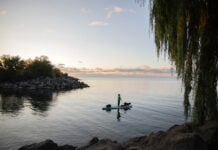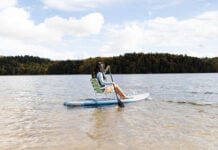The paddleboard industry is embracing environmental stewardship and the proof is in the paddling. In addition to growing grassroots sustainability initiatives, such as clean-up days and expeditions to fight plastic pollution, a growing sense of environmental responsibility has been influencing the creation of green products from manufacturers.
The modern board and paddle manufacturing process is typically full of toxic chemicals and resins. Foam, epoxy, plastic and composite cloths, such as carbon and Kevlar, all consist of synthetic materials. Many of these materials take generations to break down in a landfill, and release harmful emissions in their creation process.
Yet, as more forward-thinking companies adopt an Earth-first mentality, consumers are seeing an increasing number of eco-friendly alternatives going mainstream at reasonable prices.
Based in Austin, Texas, Jarvis Boards founder Tony Smith creates handcrafted wooden paddleboards, incorporating reclaimed lumber, sustainably harvested wood, leather and recycled foam cores in small batch production. These paddleboards also use recycled biowaste resins, as opposed to the more common petroleum-based options.
Eco-friendly initiatives are not just the domain of idealist hippies and boutique board makers anymore.
For Smith, the driving philosophy behind creating green boards is personal. “I have a 3-year-old son and I think about the consequences of our actions on the planet and how they will affect him and his kids, and so on,” says Smith. “It just doesn’t seem fair we can cause irreversible damage future generations will have to deal with. I think about designing products which will get as many people out and enjoying nature now, while minimizing impacts on the future.”
Eco-friendly initiatives are not just the domain of idealist hippies and boutique board makers anymore. A sea change is slowly occurring in larger companies.
“The majority of paddleboards are made in Asia and don’t have very strict regulations or requirements to protect the environment. BIC Sport has one of the world’s most sustainable manufacturing factories for boardsports in Vannes, France,” says Jimmy Blankeney, marketing manager at BIC Sport. The factory boasts low-energy consumption, no gas emissions and no solvents in the manufacturing process. BIC was one of the first SUP companies to embrace environmental awareness. The brand’s wooden Earth Surf & SUP boards are made from bio-sourced renewable and recycled materials, such as flax fiber, fast-growing paulownia trees and cork.
Cork is an increasingly common material in eco-friendly boards, as it can be harvested without negatively affecting the tree. Cork also has excellent water-resistant properties and is visually appealing, removing reliance on harmful dyes. It’s also durable and long-lasting, and may be recycled and reused at the end of a product’s life.
“Any sport with a close tie to our water playground tends to have enthusiasts who are more aware of our environment and develop a conscious effort to take care of it,” says Rich Price, founder of Solace SUP Boards, which uses cork deck pads in its board designs. “SUP had fast growth as a sport, which is a good thing as more people are getting out on the water having fun and connecting with nature and helping to leave it better than they found it.”
Solace SUP has also created a green board bag of hemp—a sustainable resource with a short growing cycle and a water requirement significantly less than cotton. Hemp has low environmental impact, doesn’t require pesticides to grow and yields two times more fiber than cotton in the same sized plot of land. Opting for new materials is a mentality shift for some manufacturers, for whom not so long ago, cost-effective and eco-friendly were mutually exclusive terms. Not anymore.
The creation of new green products for paddleboards is often challenging for manufacturers on a micro-level, according to Price. “Mainly because it takes more time, logistics and money to bring together the raw materials we use,” he adds. “We are in it for the long term, and as we grow I believe we can get more costs down and more people will be aware of their options.”
The hope is not so far in the future, eco-friendly manufacturing isn’t just a niche in the market, but an essential part of a board’s origin consumers have come to expect.
Eco-friendly accessories are also hitting the market in a big way. Plant-based board bags are a boon for many manufacturers, helping reduce unnecessary packaging for shipping. Board bags can reduce packaging by up to 85 percent, according to Naish, creator of the Eco Board Bag.
Starboard is another big name brand pledging a green conscious. Starboard encourages customers to become stewards of waterways by selling all of their paddles with a removable garbage picker. All Starboard’s composite boards and fins were being made with non-toxic, plant-based resins in 2017.
Whether big or small, these innovations show the cumulative efforts of the SUP industry and community can add up to significant positive impact for the environment.
“People have a hard time caring about and protecting what they don’t see. The more people out in nature, the more people will care about protecting nature. I think this is the biggest effect of the SUP industry in general,” says Smith.
Tony Smith of Jarvis Boards hard at work shaping an eco-friendly wood design. | Photo: courtesy Jarvis Boards









